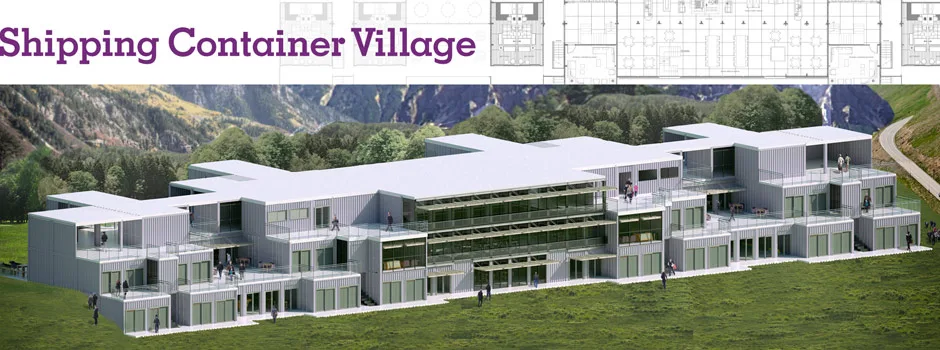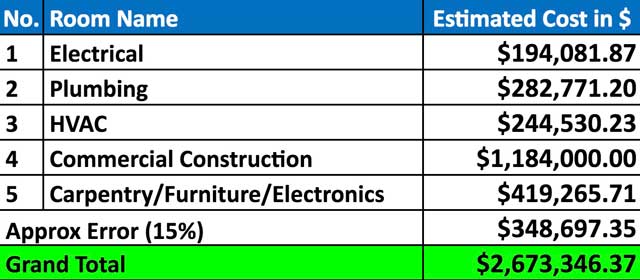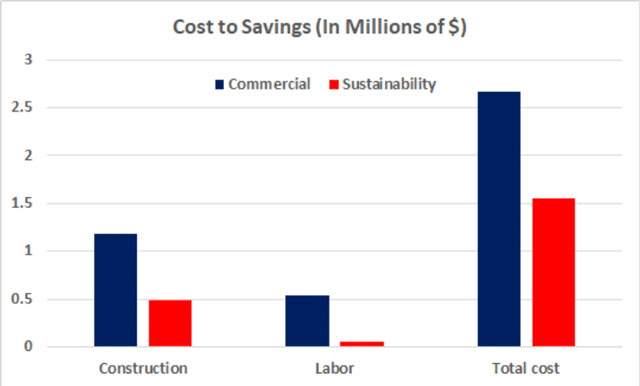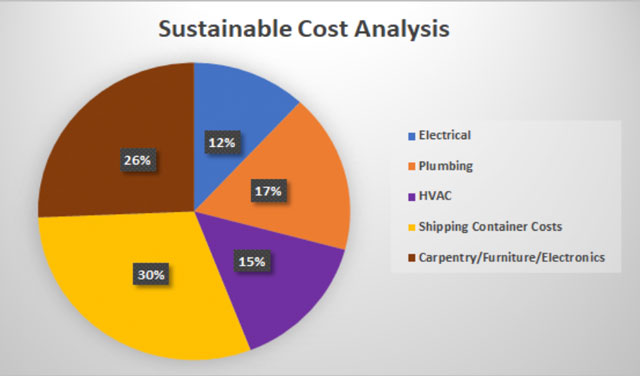
Shipping Container Village Materials & Costs
This page is the open source and free-shared Shipping Container Village construction materials costs page. It will constantly update with increasingly more accurate information as we open source project-launch blueprint the complete One Community Shipping Container Village. The goal of this page is to provide precise materials needs and costs for every component of the Shipping Container Village. We discuss this with the following sections:
- Shipping Container Village Materials & Costs Overview
- Why Open Source Shipping Container Village Materials and Costs
- Ways to Contribute
- Consultants on this Component
- Cost Analysis Details
- Adjusted Cost Summary – Making it all More Sustainable
- Resources
- Summary
- FAQ
OUR CURRENT FOCUS IS ON THE EARTHBAG VILLAGE
(CLICK HERE FOR INFORMATION ON THE EARTHBAG VILLAGE).
HERE’S HOW YOU CAN HELP WITH THAT VILLAGE MODEL
OR THIS ONE:
HELP US BUY THE PROPERTY | WAYS ANYONE CAN HELP
SHIPPING CONTAINER VILLAGE
MATERIALS & COSTS
![]() Construction with shipping containers can be significantly more affordable than traditional construction. As part of our global transformation approach to Highest Good housing, this page shares our cost analysis for using this building method to construct a commercial-sized Shipping Container Village capable of housing up to 150 people and hosting 100s more. As we go through the process of constructing this village, we will share our actual materials costs and also add here complete details for where and how to buy materials, what to buy, what to look for, what to look out for, and more.
Construction with shipping containers can be significantly more affordable than traditional construction. As part of our global transformation approach to Highest Good housing, this page shares our cost analysis for using this building method to construct a commercial-sized Shipping Container Village capable of housing up to 150 people and hosting 100s more. As we go through the process of constructing this village, we will share our actual materials costs and also add here complete details for where and how to buy materials, what to buy, what to look for, what to look out for, and more.
WHY OPEN SOURCE SHIPPING CONTAINER
VILLAGE MATERIALS & COSTS
![]() One Community’s goal is using open source construction to demonstrate sustainable building for personal and commercial use as easy, affordable, and beautiful. We are first refining and demonstrating the open source strategy and detail of our open source approach with the 3-dome cluster crowdfunding campaign, we’ll then expand this process as we open source the complete Earthbag Village (Pod 1) and Duplicable City Center®, and then we’ll do the same for this village and the other 5 villages.
One Community’s goal is using open source construction to demonstrate sustainable building for personal and commercial use as easy, affordable, and beautiful. We are first refining and demonstrating the open source strategy and detail of our open source approach with the 3-dome cluster crowdfunding campaign, we’ll then expand this process as we open source the complete Earthbag Village (Pod 1) and Duplicable City Center®, and then we’ll do the same for this village and the other 5 villages.
Open sourcing the cost analysis for this village and all others is purposed to help people better understand the cost savings that are possible through sustainable building and creation of collaborative and open source teacher/demonstration hubs. In so doing, we hope to make shipping container construction easier to understand and implement, more affordable, and more mainstream-popular for both personal and commercial use.
WAYS TO CONTRIBUTE TO EVOLVING THIS SUSTAINABILITY COMPONENT WITH US
SUGGESTIONS | CONSULTING | MEMBERSHIP | OTHER OPTIONS
CLICK THESE ICONS TO JOIN US THROUGH SOCIAL MEDIA
CONSULTANTS ON THIS COMPONENT OF ONE COMMUNITY
Jagannathan Shankar Mahadevan: Mechanical Engineer
SHIPPING CONTAINER VILLAGE
COST ANALYSIS DETAILS
 Accurately creating the cost analysis for the Shipping Container Village was a process of applying traditional cost analysis protocols and then researching the areas where these approaches needed to be adjusted to account for the differences when building with shipping containers. We discuss here the complete Shipping Container Village cost analysis process and conclusions with the following sections:
Accurately creating the cost analysis for the Shipping Container Village was a process of applying traditional cost analysis protocols and then researching the areas where these approaches needed to be adjusted to account for the differences when building with shipping containers. We discuss here the complete Shipping Container Village cost analysis process and conclusions with the following sections:
- Identifying Primary Areas Contributing to Costs
- Identifying Primary Cost Contributors within Each Area
- Energy Infrastructure Considerations
- Cost Summary as Per Commercial Standards
- Adjusted Cost Summary – Making it all More Sustainable
IDENTIFYING PRIMARY AREAS CONTRIBUTING TO COSTS
As per commercial standards (PDF), a rough estimate for the entire project is predicted in the primary cost analysis. An overview of the Shipping Container Village plan (see Plans Page) aids in segregating the 30,000 ft2 total area into 4 different areas based on the area’s purpose and location inside the village. The 4 segregated areas are listed below and clicking each link will lead to the spreadsheet tab for cost analysis for each area.
- Living/Rental Areas
- Kitchen
- Public Restrooms
- Other Common Areas that include a Game Room, Computer Room, Mediation Room, conference rooms, etc.
It is noteworthy to observe that the Shipping Container Village designs do not include any specific landscaping, so landscaping costs are not included.
Here is the summary of these costs by area:

Shipping Container Village Cost Analysis Breakdown by Area – Click for the open source spreadsheet with the most current data
IDENTIFYING PRIMARY COST CONTRIBUTORS WITHIN EACH AREA
For convenience in computations and for more accurate calculations, the following 5 independent units are assumed to have significant contribution to an area’s cost:
- Electrical
- Plumbing
- HVAC
- Material
- Carpentry/Furniture/Electronics
Each of these unit costs have been predicted across all the 4 areas using the following approaches:
ELECTRICAL
The electrical unit consists of elements responsible for powering an area. A general summary on how a residential electrical system is constructed is described here. The electrical footage cost (base cost) inclusive of wiring, labor, and overhead (a variable cost based on locality) can be obtained from here. For the current locality, the base cost is found to be an approximate $8.67/ft2. The cost for various power consuming equipment (useful devices like fans, ceiling lights, etc) are not included in the base cost and are accounted for independently.
PLUMBING
The plumbing unit is generally responsible for an area’s water supply and sewer management system (here’s a resource about this). Area-specific labor and overhead can be inputted in this web program to get an estimate of the plumbing footage. An approximate $11.42/ft2 base cost which includes the cost for piping, location-specific labor and overhead is used for the Shipping Container Village model. Additional plumbing equipment such as water sinks, bathtubs, toilets, etc., have significant impact on the total plumbing cost and have been accounted for separately.
HVAC – HEATING AND COOLING
The HVAC unit primarily maintains the temperature and humidity of an enclosed area to provide a comfortable living environment. Unlike the electrical and plumbing units, we were unable to obtain commercial and standard base-cost data for the HVAC unit. Consequently, we have used the approximate sq. ft cost of $12.51 as derived in the Straw Bale HVAC Cost Analysis section.
MATERIALS
The cost of building a structure primarily depends on setting the frames for support. This resource article (link) presents all significant parameters to consider while approximating an estimate for building a structure. With reference to this literature (link), a base cost of $40/ft2 (inclusive of materials and labor) over a useful area of 30,000 ft2 (useful area is the actual build area for the village model excluding outdoor areas) results in $1.18M for building the structure as per commercial practice.
CARPENTRY/FURNITURE/ELECTRONICS
This unit includes area-specific furniture and electronics cost, a part of which can be customized per occupant’s preference.
ENERGY INFRASTRUCTURE CONSIDERATIONS
The Highest Good Energy plan for power generation and transmission uses grid-tied and open source Wind and Solar to create a net-zero 100% sustainable energy plan. These costs continue to evolve on the Highest Good Energy hub and related open source pages. These costs are not included in the total village cost because:
- Sustainable energy is optional for anyone replicating our designs
- Accurately evaluating them for this Phase II Highest Good Housing construction is not realistic considering the speed at which sustainable energy costs continue to drop
- The details of this energy infrastructure and the “grid” costs are part of the entire One Community Highest Good Housing component and included in the Phase I construction of the Earthbag Village (Pod 1) and Duplicable City Center® and therefore not limited to the Shipping Container Village alone
COST SUMMARY AS PER COMMERCIAL STANDARDS
To create the final Commercial Cost Analysis for this structure, all of the details above plus 15% was added. The additional 15% of the total cost was further considered to account for any and all approximations in determining the estimate for this project. With all this accounted for, the total project as per commercial standard approximates upwards to $2.67M as shown below.

Shipping Container Village Commercial Cost Analysis – Click for the open source spreadsheet with the most current data
Here is a graphic showing what percentage each area contributes to the total cost:

ADJUSTED COST SUMMARY
MAKING IT ALL MORE SUSTAINABLE
 After calculating the costs for the complete Shipping Container Village as described above and with standard commercial materials and practices, we then calculated our actual costs by incorporating sustainable practices and materials. This led to the revised costs that incorporated and included consideration of the following factors:
After calculating the costs for the complete Shipping Container Village as described above and with standard commercial materials and practices, we then calculated our actual costs by incorporating sustainable practices and materials. This led to the revised costs that incorporated and included consideration of the following factors:
MATERIALS SAVINGS
According to the National Association of Home Builders (Link), it is seen that the cost for initial survey, foundation and framing (which accounts for 35.2% of total cost – approximately $32/sq. ft) almost remains the same irrespective of the build material used. An advantage of using shipping containers is that these framing costs associated with construction is mostly taken care of by the shipping containers themselves. Hence, the total cost of buying/reusing the shipping containers takes care of almost the entire construction cost. Deeper insights reveal that construction with shipping containers as per our layout results in $16.7/ft2 versus commercial cost of $40/ft^2.
Researching the costs of shipping containers, the two most common types are 40′ x 8′ and 20′ x 8′. We designed only using the smaller of the two because they are easier to transport and appear easier to acquire too. The average cost of a 20′ x 8′ shipping container is within $2000 – $4000 depending on numerous purchase factors. For our calculations, we assumed that we would purchase 185 shipping containers for this village from this vendor at a rate of $2675 per unit. This amounts to a total shipping container cost of $494,875 and this cost reduces our total materials’ costs by $689,125, or 60% on comparison with the commercial standards. This spreadsheet shows these calculations: LINK
VOLUNTEER LABOR
As per commercial practice, the base cost for electrical, plumbing and building is inclusive of labor. One Community’s open source project launch-blueprinting model for showcasing sustainability in action includes open source and DIY approaches and tutorials that will cover these areas and more. This labor and these tutorials will be created by our all-volunteer team of qualified professionals. To account for this, we’ve approximated the variable labor costs we’ll save (depending on location) to 20% of the total cost of the project.
DIRECT AND REPLICABLE MATERIALS PURCHASING
For large-scale constructions, the majority of the products that are designed and manufactured by suppliers are commonly marketed and sold through a retailer. It is often easy to under appreciate the intangible costs processed in the supplier-retailer relationship. As part of our strategy to make sustainability easier, more affordable, and more attractive, we will be developing purchasing relationships directly with suppliers that we expect to increase their profit margins while reducing consumer costs when building teacher/demonstration communities, villages, and hubs using our plans. This will also reduce our total project cost while further increasing business for the recommended supplier.
We will add here the resources and contacts for all direct purchasing options as these options are identified, used by us, and proven reliable.
ADJUSTED COSTS CONCLUSIONS, CHARTS, AND GRAPHS
The following adjusted cost analysis incorporates the building materials savings and volunteer labor savings discussed above to produce a total project estimated cost of $1.6M.

Shipping Container Village Cost Analysis Integrating Open Source Sustainability – Click for the open source spreadsheet with the most current data
Here is a chart showing the difference in cost between the conventional and sustainable models:

Overall, it is seen that the cost of sustainable construction is less than commercial construction (about $0.6M less). We can also observe a small fraction of the commercial costs for labor when applying our open source sustainability model. This is due to the use of volunteer labor. The labor cost for the commercial estimate is 20% of the total project cost. Subsequently, the labor costs for open source sustainability is assumed an approximate 10% of the commercial labor cost to address any technical intricacies.
So the total cost for the sustainable model is $1.55M versus $2.67M for the commercial construction. Here is a graphic showing the adjusted contribution of each each area to the total cost:

RESOURCES
- Calculating costs as per commercial standards – (PDF)
- A general summary on how a residential electrical system is constructed
- Area-specific labor and overhead can be inputted in this web program
- The cost of building a structure from a setting the frames perspective
- Use this page (click here) if you have a resource you’d like to suggest be added here
SUMMARY
![]() Construction with shipping containers can be significantly more affordable than traditional construction. As part of our global transformation approach to Highest Good housing, we are open source sharing our cost analysis for using this building method to construct a commercial-sized Shipping Container Village with housing for 80+ people and hosting 100s more. By open sourcing the cost analysis for this village and all others, we desire to help people better understand the cost savings that are possible through sustainable building and creation of collaborative and open source teacher/demonstration hubs. These savings, when calculated for this structure as compared to the same structure built with conventional means, are estimated to reduce the cost by about 60%.
Construction with shipping containers can be significantly more affordable than traditional construction. As part of our global transformation approach to Highest Good housing, we are open source sharing our cost analysis for using this building method to construct a commercial-sized Shipping Container Village with housing for 80+ people and hosting 100s more. By open sourcing the cost analysis for this village and all others, we desire to help people better understand the cost savings that are possible through sustainable building and creation of collaborative and open source teacher/demonstration hubs. These savings, when calculated for this structure as compared to the same structure built with conventional means, are estimated to reduce the cost by about 60%.
FREQUENTLY ANSWERED QUESTIONS
Q: Where can I get more information about the Shipping Container Village, benefits and challenges of building with shipping containers, etc.?
Please visit the Shipping Container Village open source hub.
Q: When do you anticipate starting construction on the Shipping Container Village?
We are first refining and demonstrating the open source strategy and detail of our open source approach with the 3-dome cluster crowdfunding campaign, we’ll then expand this process as we open source the complete Earthbag Village (Pod 1) and Duplicable City Center®, and then we’ll do the same for this village and the other 5 villages.
Q: Where can I get more information about your philosophies for world change?
Please take a look at each of these additional pages: (click icons)
Q: How do you intend to pay for construction of the Shipping Container Village?
One Community is projected to easily generate sufficient revenue to construct this village and the other 5 villages once the Earthbag Village (Pod 1) and Duplicable City Center® are operational. Visit the One Community Highest Good Economics page for details on our revenue streams, rental revenue projections, and other open source revenue-generation details related to this and all other aspects of One Community.
 One Community
One Community





